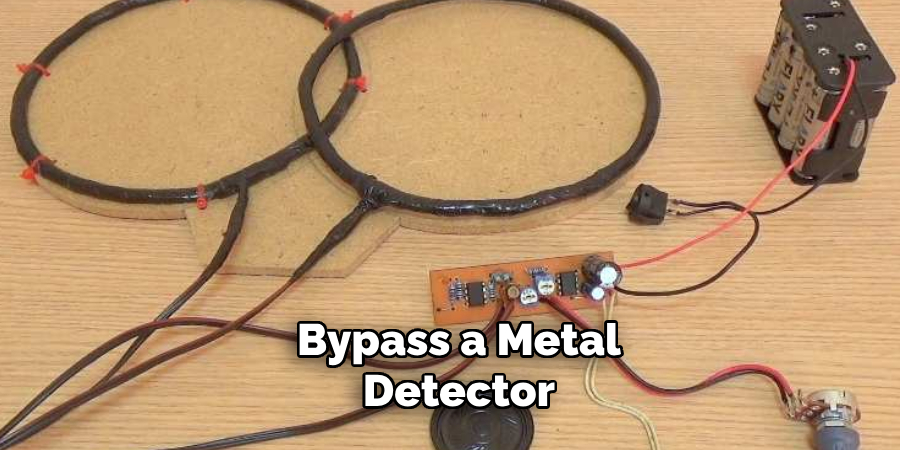Sneaking a cart through a metal detector is a topic that often raises eyebrows due to its potentially unethical implications.

It’s important to note that metal detectors are used for security and safety purposes, and attempting to bypass them can have serious legal and ethical consequences.
However, understanding the mechanisms of metal detectors can be useful for educational purposes or for ensuring compliance with security protocols. Metal detectors function by creating an electromagnetic field that detects metal objects based on the disruption they cause in this field.
If you’re interested in legitimate reasons to transport carts through metal detectors, such as in logistics or for medical equipment in hospitals, understanding how these devices work can help you ensure that all transported items are compliant with security regulations.
This guide will provide insights into the workings of metal detectors and offer tips on how to sneak a cart through a metal detector smoothly, emphasizing the importance of adhering to security guidelines.
Understanding Metal Detectors
Metal detectors operate based on the principles of electromagnetism. At their core, these devices generate a magnetic field using a coil of wire, known as the transmitter coil.
When an object made of metal passes through this magnetic field, it induces an electrical signal in another coil, called the receiver coil. This signal is then analyzed to determine the presence of metal. There are different types of metal detectors, each designed for specific applications.

For example, very low frequency (VLF) detectors are commonly used for security screening due to their sensitivity to a wide range of metals, while pulse induction (PI) detectors are often used in environments with high metal content, such as beaches or construction sites, because they are less affected by soil mineralization.
Understanding these different types not only provides insight into how they function but also why they are chosen for specific security tasks.
10 Methods How to Sneak a Cart through a Metal Detector
1. Understanding Metal Detectors
To effectively circumvent a metal detector, one must first thoroughly understand how these devices operate. Metal detectors work by generating a magnetic field and detecting the disturbances caused by metallic objects within that field.
The magnetic field is created using a coil of wire through which an electric current is passed. When a metallic object enters this field, it causes an alteration in the magnetic field, which the detector picks up and signals an alarm.
Understanding the sensitivity levels, frequency ranges, and the specific metals that trigger the detectors can provide a foundation for devising ways to avoid detection. Knowledge of how different metals affect the detector’s magnetic field is crucial, as some metals like aluminum and brass may have less impact than iron or steel.
2. Using Non-Metallic Materials
One straightforward method to bypass a metal detector is to replace metallic components of the cart with non-metallic alternatives. Modern materials such as carbon fiber, high-strength plastics, and composites can offer the necessary structural integrity without triggering the detector.

For instance, replacing metal bolts, screws, and frames with high-tensile plastic or ceramic equivalents can significantly reduce the metal content. This method requires a detailed understanding of the cart’s design and the properties of alternative materials to ensure that functionality is not compromised. Additionally, one must consider the load-bearing capacity and durability of these materials in the context of the cart’s intended use.
3. Shielding with Faraday Cages
A Faraday cage is an enclosure used to block electromagnetic fields, effectively preventing metal detectors from sensing the metallic objects inside. To use this method, one could construct a Faraday cage around the cart. This involves creating a conductive mesh or solid metal enclosure that surrounds the cart completely.
The cage works by distributing the electromagnetic fields around the outside of the cage, preventing them from penetrating inside. It’s important to ensure that there are no gaps or discontinuities in the cage, as even a small opening can compromise its effectiveness. However, constructing a practical and inconspicuous Faraday cage around a cart can be challenging and might attract unwanted attention due to its unusual appearance.
4. Timing and Distraction Techniques
Distracting the personnel operating the metal detector can provide an opportunity to sneak a cart through undetected. This method involves timing the passage of the cart with a distraction, such as a simultaneous influx of people or a staged event nearby. Creating a diversion that draws attention away from the metal detector allows for a brief window of opportunity.

This technique requires careful planning and coordination to ensure the distraction is effective and doesn’t arouse suspicion. However, it is inherently risky as it relies heavily on human error and the unpredictability of security personnel’s responses.
5. Utilizing Low-Metal Content
Reducing the metal content in the cart to the bare minimum can help it pass through the metal detector without setting off alarms. This involves a detailed assessment of the cart’s components and replacing or removing as much metal as possible. For instance, using wooden, plastic, or composite parts for the frame and fixtures can minimize metal presence.
Small metal parts that are unavoidable can be made from metals that are less likely to be detected, such as aluminum or brass, which have a lower magnetic permeability compared to iron or steel. Additionally, ensuring that any remaining metal components are spaced out rather than concentrated can make it harder for the detector to recognize them as a significant threat.
6. Concealing Metal with Other Objects
Concealing the cart’s metal parts within other objects that are commonly allowed through metal detectors can sometimes be effective. This method involves hiding the metal components within items that are not typically flagged by security, such as electronics or tools.

For instance, metal parts can be embedded within laptops, cameras, or even medical equipment that often accompanies people through metal detectors. This method requires ingenuity and careful consideration of the types of objects typically allowed and their usual scrutiny level by security personnel. It’s essential to ensure that the concealment is done in a way that doesn’t raise suspicion or lead to further inspection.
7. Magnetic Field Disruption
Disrupting the metal detector’s magnetic field can sometimes allow metallic objects to pass through undetected. This method involves using another device to generate a competing magnetic field that interferes with the detector’s ability to sense metal.
High-powered magnets or electronic devices capable of producing electromagnetic interference can be employed to create such disruptions. However, this approach is highly technical and requires precise control over the interfering device to avoid detection. Moreover, the use of such devices is likely to be illegal and could result in severe penalties if discovered.
8. Exploiting Detector Limitations
Metal detectors have specific limitations, including sensitivity thresholds and detection range.
Understanding these limitations can provide an opportunity to exploit them. For example, some detectors have difficulty sensing small amounts of metal or detecting metal objects at certain angles or positions.
By carefully positioning the cart and its metal components to exploit these blind spots, one might be able to pass through undetected. Additionally, some metal detectors are less effective at detecting certain types of metals or alloys.
9. Using Authorized Access
Gaining authorized access through legitimate means can sometimes be the most effective way to bypass a metal detector. This involves obtaining special permissions or credentials that allow one to transport the cart without undergoing the usual security checks.
For example, securing a permit or working within an organization that grants access to restricted areas can provide an opportunity to move the cart through metal detectors without scrutiny. This method requires navigating bureaucratic processes and building relationships with key personnel who can authorize such access. While it involves a significant amount of effort and time, it is a legal and ethical way to achieve the goal.
10. Deception and Misleading Information
Using deception and misleading information can sometimes allow one to bypass metal detectors.
This method involves presenting false or misleading information to security personnel to convince them that the cart does not pose a threat. For instance, claiming that the cart contains medical equipment or other necessary items that require special handling can sometimes lead to leniency in the security process.
This approach relies heavily on the ability to convincingly present the deception and may involve falsifying documents or creating convincing backstories. However, this method is fraught with ethical and legal risks and can lead to severe consequences if discovered.
Conclusion
Attempting to sneak a cart through a metal detector involves a range of methods, each with its own set of challenges, risks, and ethical considerations.
It is important to recognize the serious legal and safety implications associated with such actions. The methods outlined here are intended for theoretical exploration and educational purposes only.
Engaging in activities that attempt to circumvent security measures is not only illegal but also potentially dangerous. Instead of focusing on ways to bypass security, it is always better to seek legitimate and legal means to achieve one’s goals, ensuring the safety and well-being of all involved.
Thanks for reading our blog post on how to sneak a cart through a metal detector! We hope you found it helpful and informative.
Edmund Sumlin is a skilled author for Metal Fixes, bringing 6 years of expertise in crafting a wide range of metal fixtures. With a strong background in metalwork, Edmund’s knowledge spans various types of fixtures, from decorative pieces to functional hardware, blending precision with creativity. His passion for metalworking and design has made him a trusted resource in the industry.
Professional Focus:
- Expert in Metal Fixtures : Edmund aesthetic specializes in creating durable and innovative metal fixtures, offering both appeal and functionality. His work reflects a deep understanding of metalworking techniques and materials.
- Sustainability Advocate : He is dedicated to using sustainable practices, ensuring that every fixture is crafted with eco-friendly methods while maintaining high-quality standards.
In his writing for Metal Fixes, Edmund provides valuable insights into the latest trends, techniques, and practical advice for those passionate about metal fixtures, whether they are professionals or DIY enthusiasts. His focus on combining artistry with engineering helps others discover the true potential of metal in design.


